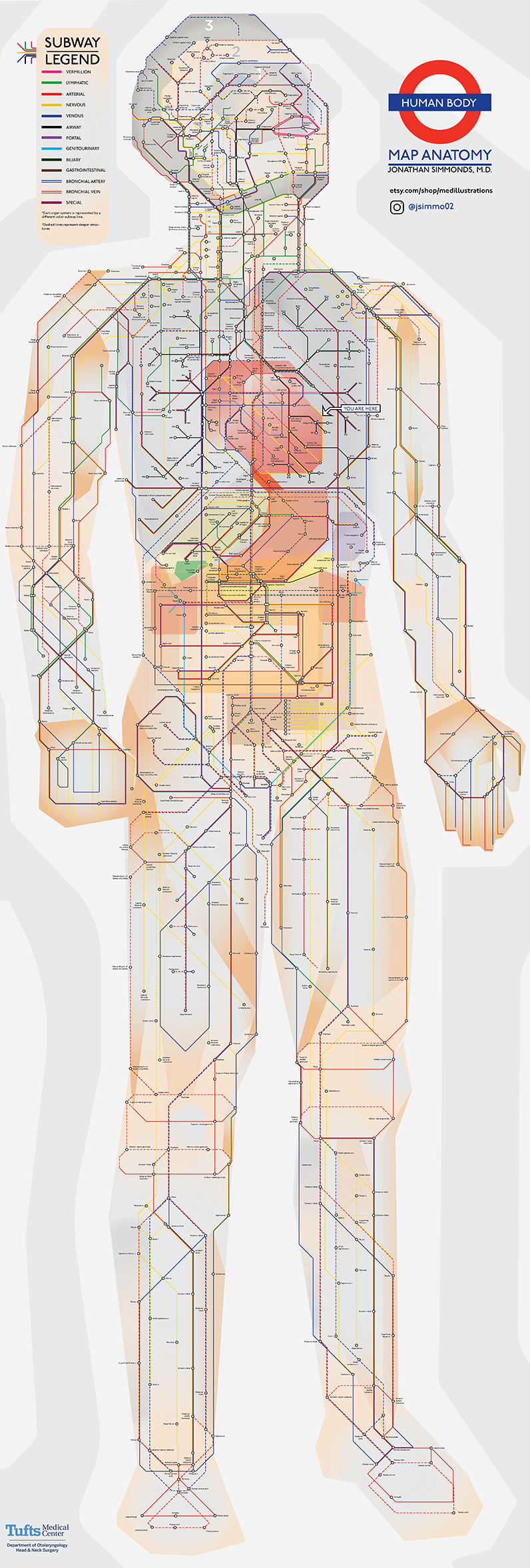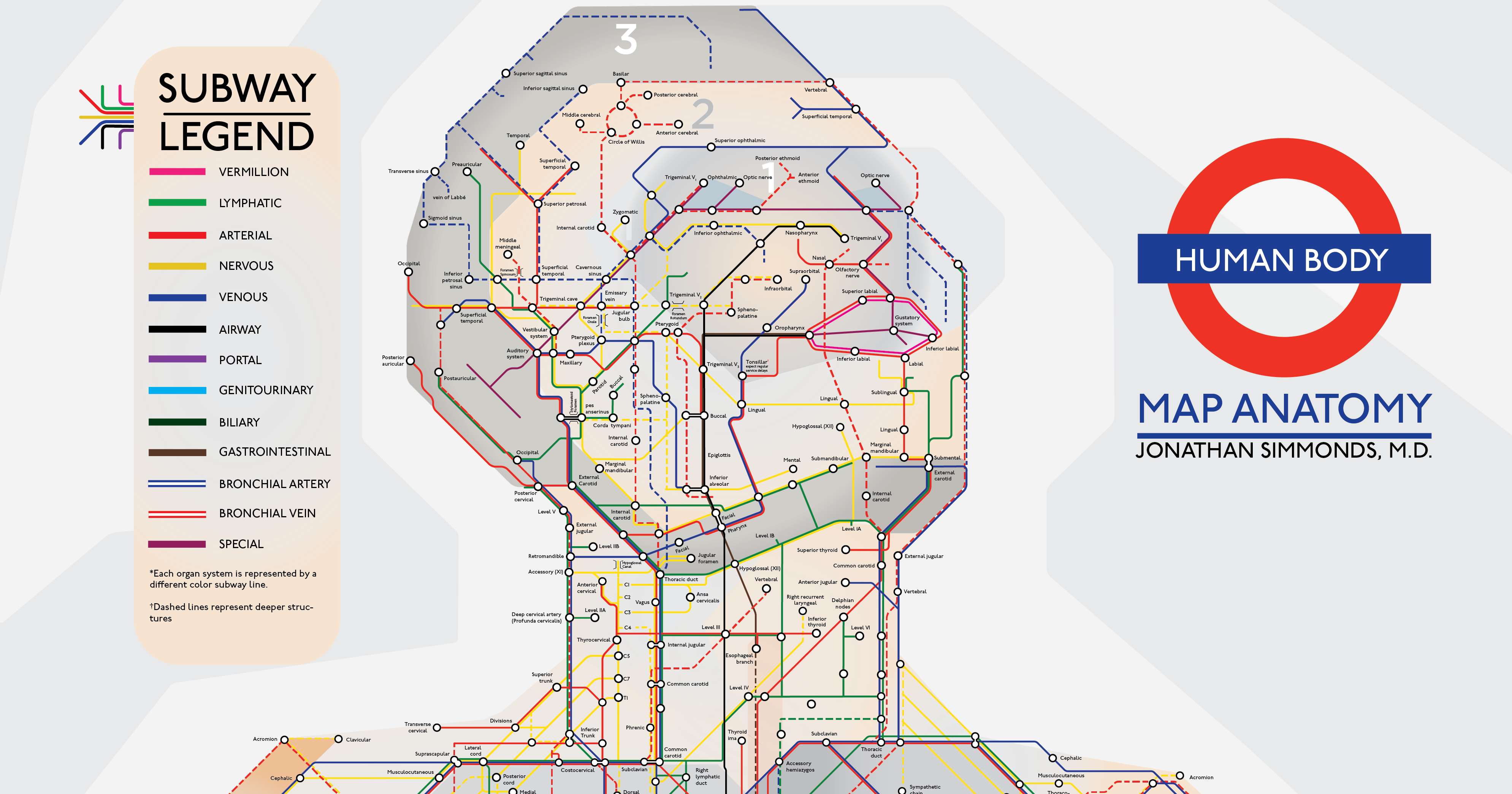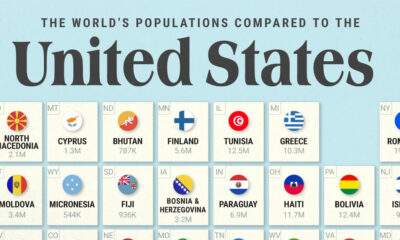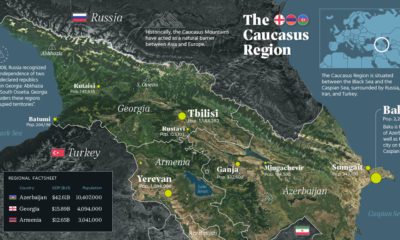Misc
An Illustrated Subway Map of Human Anatomy
What comes to mind when you think about your body?
Most people might imagine an intricate network of blood vessels or the complex neural circuits of the brain. Or we might picture diagrams from the iconic medical textbook, Gray’s Anatomy.
Today’s visualization puts a unique spin on all of these ideas – interpreting human anatomy in the style of London’s transit system. Created by Jonathan Simmonds M.D., a resident physician at Tufts Medical Center, it’s a simple yet beautifully intuitive demonstration of how efficiently our bodies work.
View a high resolution version of this graphic.

Make sure to view the full resolution version of this intricate visualization.
From Point A to Point Z
Right away, we can see that each system is broken down into a few major colored ‘lines’. Here are a few:
- Vermillion system (Pink line)
This covers one of the smallest surface areas, namely the boundary around the mouth from the cupid’s bow to the bottom lip. - Airway system (Black line)
This represents the sections from the nose and mouth, down the windpipe and into the lungs. The system also works with bronchial arteries and veins – the striped blue and red lines respectively. - Nervous system (Yellow line)
This starts from the temporal lobe of the brain, and reaches all the way to the body’s extremities, such as the fingertips and feet. - Portal system (Purple line)
Approximately 75% of blood flowing from the liver passes through portal veins, which are one of two sets of veins connected to the liver. - Special system (Magenta line)
This includes organs responsible for four of the five traditional senses – sight, hearing, smell, and taste – as well the reproductive organs.
While dashed lines represent deeper structures, sections with ‘transfers’ show where different organ systems intersect. The head is also helpfully categorized into three ‘zones’.
Of course, it’s not as straightforward as starting in one place and ending up on the opposite end – as with city transit systems, there are multiple routes that can be taken. If you’re still daunted by where to start with this map of human anatomy, there’s a helpful “You Are Here” at the heart.
To counter common biases in the medical field, Dr. Simmonds has noted that he will soon update the illustration to include racialized and female versions.
An Enduring Symbol
From a broader design perspective, this anatomical subway map draws inspiration from the famous London Underground design.
When engineering draftsman Harry Beck debuted this map back in the 1930s, it caused quite a stir. Many argued that it wasn’t geographically accurate, and that its scale was wildly skewed.
But that didn’t matter to most commuters. Beck’s map offered something that no one else did – it combined all the different lines into one pocket-sized diagram.
Beck’s map was revolutionary in its simplicity.
– Sam Mullins, London Transport Museum Director
As a result, the Tube’s linear, color-coded aesthetic is arguably the most recognizable transit map in the world today. Many major cities hopped on board with the timeless new look, such as Sydney and Paris.
This iconic subway map design has been used as a visual reference for everything from Ancient Roman roads to the Milky Way. That’s what makes it such a good application for the most complex network of all – the human body.
VC+
VC+: Get Our Key Takeaways From the IMF’s World Economic Outlook
A sneak preview of the exclusive VC+ Special Dispatch—your shortcut to understanding IMF’s World Economic Outlook report.

Have you read IMF’s latest World Economic Outlook yet? At a daunting 202 pages, we don’t blame you if it’s still on your to-do list.
But don’t worry, you don’t need to read the whole April release, because we’ve already done the hard work for you.
To save you time and effort, the Visual Capitalist team has compiled a visual analysis of everything you need to know from the report—and our VC+ Special Dispatch is available exclusively to VC+ members. All you need to do is log into the VC+ Archive.
If you’re not already subscribed to VC+, make sure you sign up now to access the full analysis of the IMF report, and more (we release similar deep dives every week).
For now, here’s what VC+ members get to see.
Your Shortcut to Understanding IMF’s World Economic Outlook
With long and short-term growth prospects declining for many countries around the world, this Special Dispatch offers a visual analysis of the key figures and takeaways from the IMF’s report including:
- The global decline in economic growth forecasts
- Real GDP growth and inflation forecasts for major nations in 2024
- When interest rate cuts will happen and interest rate forecasts
- How debt-to-GDP ratios have changed since 2000
- And much more!
Get the Full Breakdown in the Next VC+ Special Dispatch
VC+ members can access the full Special Dispatch by logging into the VC+ Archive, where you can also check out previous releases.
Make sure you join VC+ now to see exclusive charts and the full analysis of key takeaways from IMF’s World Economic Outlook.
Don’t miss out. Become a VC+ member today.
What You Get When You Become a VC+ Member
VC+ is Visual Capitalist’s premium subscription. As a member, you’ll get the following:
- Special Dispatches: Deep dive visual briefings on crucial reports and global trends
- Markets This Month: A snappy summary of the state of the markets and what to look out for
- The Trendline: Weekly curation of the best visualizations from across the globe
- Global Forecast Series: Our flagship annual report that covers everything you need to know related to the economy, markets, geopolitics, and the latest tech trends
- VC+ Archive: Hundreds of previously released VC+ briefings and reports that you’ve been missing out on, all in one dedicated hub
You can get all of the above, and more, by joining VC+ today.
-

 Debt1 week ago
Debt1 week agoHow Debt-to-GDP Ratios Have Changed Since 2000
-

 Markets2 weeks ago
Markets2 weeks agoRanked: The World’s Top Flight Routes, by Revenue
-

 Countries2 weeks ago
Countries2 weeks agoPopulation Projections: The World’s 6 Largest Countries in 2075
-

 Markets2 weeks ago
Markets2 weeks agoThe Top 10 States by Real GDP Growth in 2023
-

 Demographics2 weeks ago
Demographics2 weeks agoThe Smallest Gender Wage Gaps in OECD Countries
-

 United States2 weeks ago
United States2 weeks agoWhere U.S. Inflation Hit the Hardest in March 2024
-

 Green2 weeks ago
Green2 weeks agoTop Countries By Forest Growth Since 2001
-

 United States2 weeks ago
United States2 weeks agoRanked: The Largest U.S. Corporations by Number of Employees















